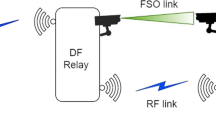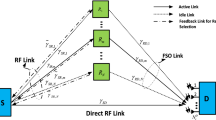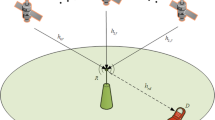Abstract
In this paper, we investigate the performance of an asymmetric radio frequency/free space optical (RF/FSO) hybrid satellite–terrestrial cooperative system with two relays utilizing a non-linear decoder (NLD) and a low-complexity piecewise linear (PL) decoder. The satellite transmits data over the RF links to the relays on the ground and the relays follow the decode-and-forward (DF) protocol and transmit the decoded data to a distant destination over FSO links assuming the constant transmit power constraint. The RF and FSO channels of the asymmetric system are assumed to follow the Shadowed-Rician and Gamma–Gamma distributions, respectively. The relays are assumed to have hybrid RF/FSO capabilities and utilize subcarrier intensity modulation scheme for transmitting the decoded signal to the destination. A NLD is derived at the destination of considered system for M-ary phase-shift keying and utilizing the derived NLD, we obtain the error rate and its upper bound. Further, in order to reduce the decoding complexity a PL decoder is derived, which is a sub-optimal decoder and works very close to the NLD. Utilizing the derived PL decoder we obtain a closed form expression of bit error rate for the considered system. Lastly, we show the effect of imperfect channel estimation and optimized power distribution of the relays on the performance of the DF based FSO cooperative system with two relays.








Similar content being viewed by others
References
Kedar, D., & Arnon, S. (2004). Urban optical wireless communication networks: The main challenges and possible solutions. IEEE Communications Magazine, 42(5), 2–7.
Sharma, N., Bansal, A., & Garg, P. (2015). Generalized OSTBC based subcarrier intensity modulated MIMO optical wireless communication system. International Journal of Communication Systems. doi:10.1002/dac.3118.
Sharma, N., Bansal, A., & Garg, P. (2015). SER analysis of selective DF relaying based OWC system with generalized turbulence. Transactions on Emerging Telecommunications Technologies. doi:10.1002/ett.3026.
Berioli, M., Chaves, J. M., Courville, N., Boutry, P., Fondere, J. L., Skinnemoen, H., et al. (2011). WISECOM: A rapidly deployable satellite backhauling system for emergency situations. International Journal of Satellite Communications and Networking, 29(5), 419–440.
Del Re, E. (2009). SALICE—Satellite-assisted localization and communication systems for emergency services. In Proceeding of the 1st international conference on wireless communication, vehicular technology, information theory and aerospace and electronic systems technology (2009). Wireless VITAE (2009). Aalborg, Denmark.
Ahn, D. S., Kim, H. W., Ahn, J., & Park, D. C. (2011). Integrated/hybrid satellite and terrestrial networks for satellite IMT-Advanced services. International Journal of Satellite Communications and Networking, 29(3), 269–282.
Morosi, S. (2010). Cooperative strategies of integrated satellite/terrestrial systems for emergencies. In Proceeding of the 2nd international ICST conference on personal satellite services, PSATS, 2010, Rome, Italy.
Leitgeb, E. (2005). Hybrid wireless networks combining WLAN, FSO and satellite technology for disaster recovery. In Proceedings of the 15th IST mobile wireless commununication summit (pp. 1–5).
Sharma, N., Bansal, A., & Garg, P. (2015). Relay selection in mixed RF/FSO system over generalized channel fading. Transactions on Emerging Telecommunications Technologies. doi:10.1002/ett.3010.
Samimi, H., & Uysal, M. (2013). End-to-end performance of mixed RF/FSO transmission systems. IEEE/OSA Journal of Optical Communications and Networking, 5(11), 1139–1144.
Ansari, I. S., Alouini, M. S., & Yilmaz, F. (2013). On the performance of hybrid RF and RF/FSO fixed gain dual-hop transmission systems. In Saudi international electronics, communications and photonics conference (SIECPC), 2013 (pp. 1–6). Fira.
Ansari, I. S., Yilmaz, F., & Alouini, M. S. (2013). Impact of pointing errors on the performance of mixed RF/FSO dual-hop transmission systems. IEEE Wireless Communications Letters, 2(3), 351–354.
Zedini, E., Ansari, I. S., & Alouini, M. S. (2015). Performance analysis of mixed Nakagami-m and Gamma–Gamma dual-hop FSO transmission systems. IEEE Photonics Journal, 7(1), 1–20.
Bansal, A., Bhatnagar, M. R., Hjorungnes, A., & Han, Z. (2013). Low-complexity decoding in DF MIMO relaying system. IEEE Transactions on Vehicular Technology, 62(3), 1123–1137.
Peppas, K. P., & Datsikas, C. K. (2010). Average symbol error probability of general-order rectangular quadrature amplitude modulation of optical wireless communication systems over atmospheric turbulence channels. Journal of Optical Communications and Networking, 2(2), 102–110.
Popoola, W. O. (2009). Subcarrier intensity modulated free-space optical communication systems. Doctoral thesis, Northumbria University.
Abdi, A., Lau, W. C., Alouini, M. S., & Kaveh, M. (2003). A new simple model for land mobile satellite channels: First- and second-order statistics. IEEE Transactions on Wireless Communications, 2(3), 519–528.
Bhatnagar, M. R., & Anees, S. (2015). On the performance of Alamouti scheme in Gamma–Gamma fading FSO links with pointing errors. IEEE Wireless Communications Letters, 4(1), 94–97.
Magnus, W., Oberhettinger, F., & Soni, R. P. (1966). Formulas and theorems for the special functions of mathematical physics (3rd ed.). New York: Springer.
García-Zambrana, A., Castillo-Vázquez, C., & Castillo-Vázquez, B. (2010). On the capacity of FSO links over Gamma–Gamma atmospheric turbulence channels using OOK signaling. EURASIP Journal on Wireless Communications and Networking. doi:10.1155/2010/127657.
Gradshteyn, I. S., & Ryzhik, I. M. (2000). Table of integrals, series, and products (6th ed.). San Diego, CA: Academic Press.
Trees, H. L. V. (2001). Detection, estimation, and modulation theory: Part I. Detection, estimation, and linear modulation theory. New York: Wiley.
Bayaki, E., Schober, R., & Mallik, R. K. (2009). Performance analysis of MIMO free-space optical systems in Gamma–Gamma fading. IEEE Transactions on Communications, 57(11), 3415–3424.
Fenton, L. (1960). The sum of log-normal probability distributions in scatter transmission systems. IRE Transactions on Communications Systems, 8(1), 57–67.
Proakis, J. G., & Salehi, M. (2008). Digital communications (5th ed.). New york: McGraw-Hill Book Company.
Author information
Authors and Affiliations
Corresponding author
Appendix: Proof of Theorem 1
Appendix: Proof of Theorem 1
Let us state some useful transformation results before providing the Proof of Theorem 1.
-
If \(W\sim {\mathcal {N}}(\mu ,\sigma ^2)\), where \({\mathcal {N}}(\mu ,\sigma ^2)\) denotes the real valued normal distribution with mean \(\mu\) and variance \(\sigma ^2\), then \(S=\exp (W)\sim {\text {Log}}{\mathcal {N}}(\mu ,\sigma ^2)\), where \({\text {Log}}{\mathcal {N}}(.,.)\) denote log-normal distribution.
-
If \(S=\exp (W)\sim {\text {Log}}{\mathcal {N}}(\mu ,\sigma ^2)\), then \(aS\sim {\text {Log}}{\mathcal {N}}(\ln (a)+\mu ,\sigma ^2)\), where a is a constant.
-
If \(S_p=\exp (W_p)\sim {\text {Log}}{\mathcal {N}}(\mu _p,\sigma _p^2)\), \(p=1,2,\dots ,N\), where \(W_p\sim {\mathcal {N}}(\mu _p,\sigma ^2_p)\) are fully correlated random variables, then \(S=\sum _{p=1}^{N}S_p\) approximately follows the log-normal distribution [24] i.e., \(S\sim {\text {Log}}{\mathcal {N}}(\mu _s,\sigma _s^2)\), where
$$\begin{aligned} \mu _s=\ln \left[ \sum _{p=1}^{N}e^{\mu _p+\frac{\sigma _p^2}{2}}\right] -\frac{\sigma _s^2}{2}, \end{aligned}$$(30)and
$$\begin{aligned} \sigma _{s}^{2}=\ln \left[ \frac{ \begin{array}{c} \sum _{p=1}^{N} e^{2\mu _p+\sigma _p^{2}}(e^{\sigma _p^{2}}-1)+2\sum _{p=1}^{N - 1} \sum _{q=p + 1}^{N} \\ \times e^{\mu _p+\frac{\sigma _p^{2}}{2}+\mu _q+\frac{\sigma _q^{2}}{2}}(e^{\sigma _p\sigma _q}-1) \end{array} }{\left( \sum _{p=1}^{N}e^{\mu _p+\frac{\sigma _p^{2}}{2}}\right) ^2}+1\right] , \end{aligned}$$(31) -
If \(S_1\sim {\text {Log}}{\mathcal {N}}(\mu _{s_1},\sigma _{s_1}^2)\) and \(S_2\sim {\text {Log}}{\mathcal {N}}(\mu _{s_2},\sigma _{s_2}^2)\) are fully correlated log-normal distributed random variables, then \(S_1/S_2\sim {\text {Log}}{\mathcal {N}}(\mu _{s_1}-\mu _{s_2},\sigma _{s_1}^2+\sigma _{s_2}^2+2\sigma _{s_1}\sigma _{s_2})\) [25].
It is observed from (14) that \(\kappa _i\), \(i=1,2,3,4\) are real gaussian and fully correlated random variables. Utilizing the above stated transformations in (13) we can say that \(X_i\sim {\text {Log}}{\mathcal {N}}(\mu _{x_i},\sigma _{x_i}^2)\) and \(Y_i\sim {\text {Log}}{\mathcal {N}}(\mu _{y_i},\sigma _{y_i}^2)\), \(i=1,2,3,4\). Thus the mean and variance of \(X_i\) will be:
Similarly, the mean and variance of \(Y_i\) can be obtained. Let \(X\triangleq \sum _{i=1}^{4}X_i\) and \(Y\triangleq \sum _{i=1}^{4}Y_i\), thus we can say that \(X\sim {\text {Log}}{\mathcal {N}}(\mu _x,\sigma _x^2)\) and \(Y\sim {\text {Log}}{\mathcal {N}}(\mu _y,\sigma _y^2)\). Further, with the use of given transformations in (12), it is observed that the LLR decoder approximately follows the real valued normal distribution with mean \((\mu _x-\mu _y)\) and variance \((\sigma _x^2+\sigma _y^2+2\sigma _x\sigma _y)\).
Based on the correct and erroneous decoding at both relays, there can be four possible events with probability of occurrence \({\text {Pr}}({\mathcal {D}}_i|h_{1},h_{2})\) given in Table 1. Therefore, the average probability of error conditioned over the channel coefficients, \(I_1\) and \(I_2\) is given in (19).
Rights and permissions
About this article
Cite this article
Sharma, N., Bansal, A. & Garg, P. Performance of DF Based Dual-Hop Dual-Path Hybrid RF/FSO Cooperative System. Wireless Pers Commun 91, 1003–1021 (2016). https://doi.org/10.1007/s11277-016-3510-7
Published:
Issue Date:
DOI: https://doi.org/10.1007/s11277-016-3510-7




